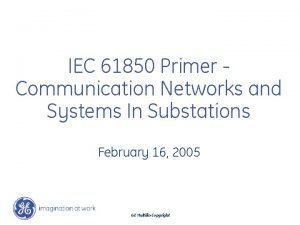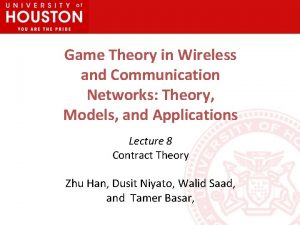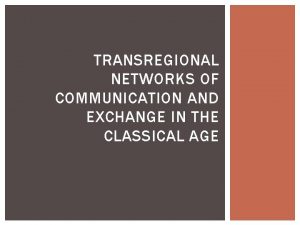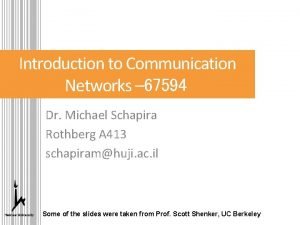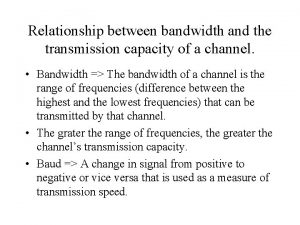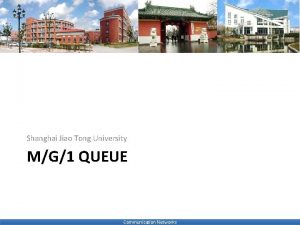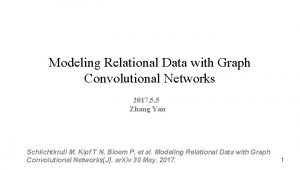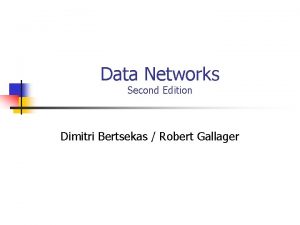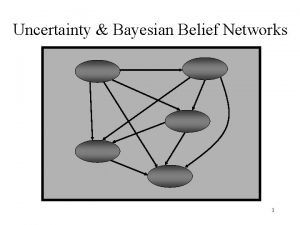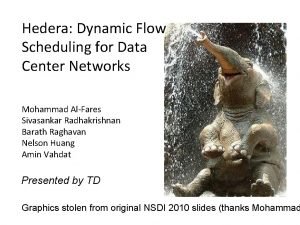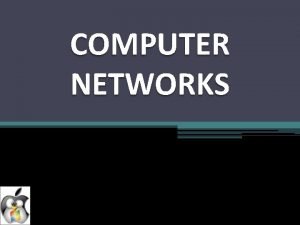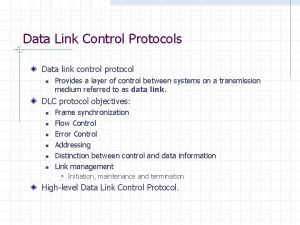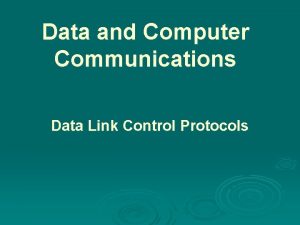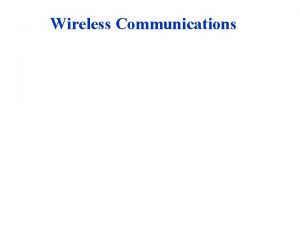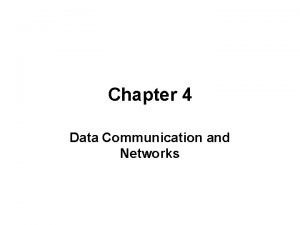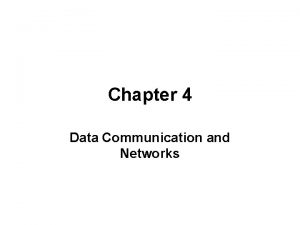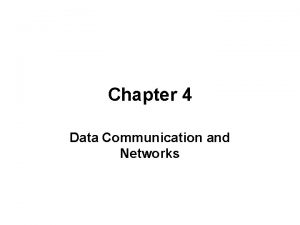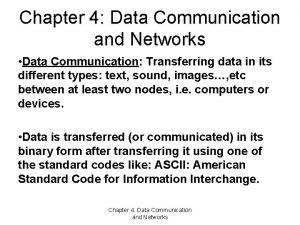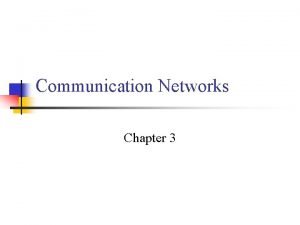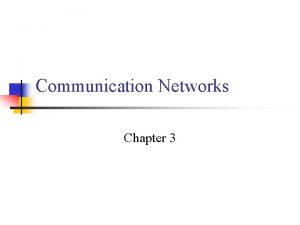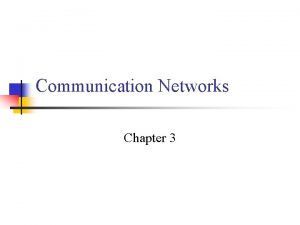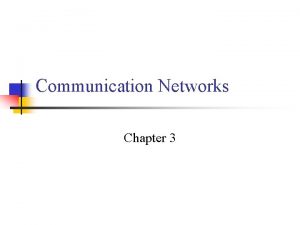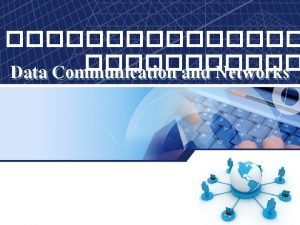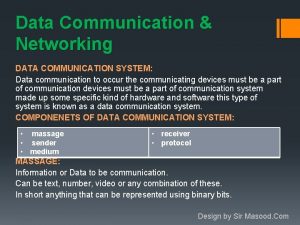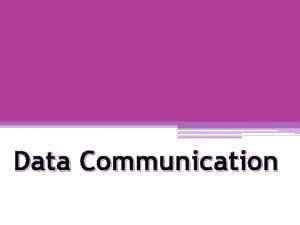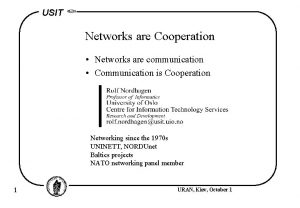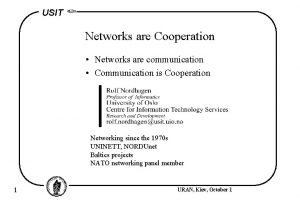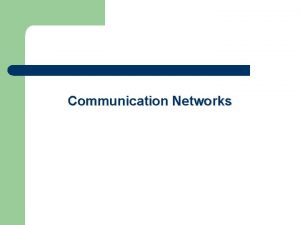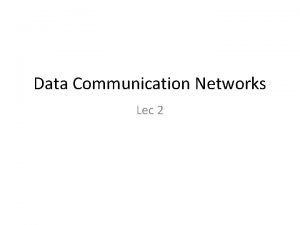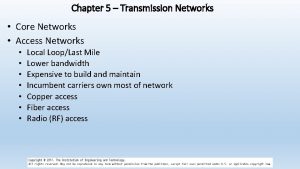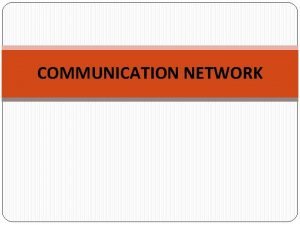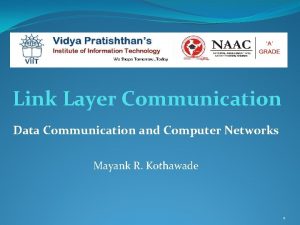Chapter 4 Data Communication and Networks Data Communication























- Slides: 23

Chapter 4 Data Communication and Networks

• Data Communication: –Transferring data in its different forms: text, sound, images…, etc between at least two nodes. –Data is transferred through a connection medium in its binary representation form. –Examples of connection medium: • Copper wires, Optical fibers, wireless, and storage media Chapter 4: Data Communication and Networks 2

• Computer Network: – is a collection of computers and devices that are connected with each other using communication channels. –allowing users to communicate and share resources. Chapter 4: Data Communication and Networks 3

• Benefits of Computer Networks 1 - Sharing Hardware: Sharing a printer. Chapter 4: Data Communication and Networks 4

2 - Sharing Software: Sharing applications and Programs and software tools. –For example: sharing a set of CDs or DVDs on a central server. • Other uses of Networks –Communication between users: video messages, faxes, chatting, and voice messages. –Providing services for customers, examples are: ECommerce, E-Government. Chapter 4: Data Communication and Networks 5

• Networks Types There are two types of Networks classified according to the size of the geographical area they cover. 1. Local Area Networks (LANs) 2. Wide Area Network (WAN) Chapter 4: Data Communication and Networks 6

1 - Local Area Networks (LANs): –A group of nodes (Computers and Devices) that are connected to each other in a limited geographical area, has a limited number of users and a common administration. –Examples: university, home, hospital. . . etc. LAN Characteristics: • Used in small geographical areas. • Offer high-speed communications. • Use LAN-specific devices such as repeaters, hubs and network interface cards. Chapter 4: Data Communication and Networks 7

LANs are divided into two Types: A- Client/ Server Architecture: –Divide computers in a network into two groups: service provider (named server), and service requester (named client). –The server provides services and functions to clients such as: printing, sharing files, databases, internet connection, …etc. Chapter 4: Data Communication and Networks 8

Chapter 4: Data Communication and Networks 9

B-Peer-to-Peer Networks: • Is where computers can act as both clients and servers, simultaneously. Computers share resources among them. • Can be found in: home network, small office network Chapter 4: Data Communication and Networks 10

2 - Wide Area Networks (WAN): –Used to connect two or more LANs that are distant from each other. –It may connect LANs in different cities or countries. –It is also used to connect the ATM banks. –The largest WAN is the Internet. Chapter 4: Data Communication and Networks 11

• WAN Characteristics: –Cover large areas – may span the world. –Compared to LANs – slow speed communication. –Devices such as routers, modems and WAN switches is used. Chapter 4: Data Communication and Networks 12

• Physical Media (Transmission Media) There are two types of transmission media: –Copper Media. –Fiber Media –Wireless media. Copper Media: 1 - Twisted pairs. 2 - Coaxial cables. Chapter 4: Data Communication and Networks 13

1 - Twisted Pairs: It is the most commonly used network cabling, is similar to the wiring that is used to connect your telephone. Chapter 4: Data Communication and Networks 14

2 - Coaxial Cables: These are similar to the cables used for connecting television to the antenna or the receiver. Highly resistant to noise and supports greater cable lengths. Chapter 4: Data Communication and Networks 15

Fiber Optics: An optical fiber (or optical fiber) is a flexible, transparent fiber made of a pure glass (silica) not much wider than a human hair. It functions as a waveguide, or "light pipe", to transmit light between the two ends of the fiber. Chapter 4: Data Communication and Networks 16

Wireless Media: • Standard IEEE 802. 11 (Wi-Fi) –Wireless LAN that uses a high frequency radio technology similar to digital cellular technology. • Bluetooth –A short range wireless technology, with space arrange from 10 up t 0 30 meters. • Standard IEEE 802. 16 (Wi. MAX) –Is a wireless digital communications system designed to enable high-speed mobile internet access to a number of devices including PCs, handsets, smart phones, cameras, …etc. Chapter 4: Data Communication and Networks 17

Wireless Media (continue…) • 3 G Mobile Technology: – The term 3 G refers to the third generation of mobile technology. – As 2 G allowed only voice, 3 G can deliver voice and multimedia. – It allows simultaneous use of speech and data services at higher data rates. Chapter 4: Data Communication and Networks 18

Wireless Media (continue…) • 4 G Mobile Technology – There are very few provider for this technology around the world. Chapter 4: Data Communication and Networks 19

Wireless Media (continue…) • 2 G Mobile Technology or GSM (Global System for Mobile Communication) – Is a digital mobile telephony system. – It’s introduced low-cost implementation of SMS. – Newer version introduced General Packet Radio Services (GPRS) that support Multimedia Messaging Servceis (MMS) and Wireless Application Protocol (WAP). Chapter 4: Data Communication and Networks 20

Wireless Media (continue…) • Satellite Communications: – Is an artificial satellite stationed in space for the purpose telecommunications. • Example of applications: – Television signal, Satellite radio, military uses, GPS. Chapter 4: Data Communication and Networks 21

Wireless Media (continue…) • Radio Frequency Identification (RFID): – Is a system that transmits the identity of an object wirelessly, using radio waves. • Example: – Animal identification, libraries, transportation payments, tracking. Chapter 4: Data Communication and Networks 22

Wireless Media (continue…) • Infrared Signal (IR): – Is an electromagnetic radiation. – Employed in short range communication, no more than 5 meters. – Example: – connecting computer peripherals and personal digital assistants. Chapter 4: Data Communication and Networks 23
 Difference between datagram and virtual circuit operation
Difference between datagram and virtual circuit operation Backbone networks in computer networks
Backbone networks in computer networks Iec 61850 communication networks and systems in substations
Iec 61850 communication networks and systems in substations Game theory in wireless and communication networks
Game theory in wireless and communication networks Networks of communication and exchange
Networks of communication and exchange Introduction to communication networks
Introduction to communication networks A communication processor that connects dissimilar networks
A communication processor that connects dissimilar networks Industrial communication networks
Industrial communication networks Communication networks
Communication networks Delay models in data networks
Delay models in data networks Modeling relational data with graph convolutional networks
Modeling relational data with graph convolutional networks Data networks bertsekas
Data networks bertsekas Data link layer switching
Data link layer switching Bayesian belief networks in data mining
Bayesian belief networks in data mining Data link layer design issues in computer networks
Data link layer design issues in computer networks Hdlc categories
Hdlc categories Digital data to digital signal encoding
Digital data to digital signal encoding Hedera: dynamic flow scheduling for data center networks
Hedera: dynamic flow scheduling for data center networks Elementary data link protocols in computer networks
Elementary data link protocols in computer networks Flow control protocols
Flow control protocols Flow control protocols in data link layer
Flow control protocols in data link layer Networks and graphs: circuits, paths, and graph structures
Networks and graphs: circuits, paths, and graph structures Wired media and wireless media
Wired media and wireless media Andrea goldsmith wireless communications
Andrea goldsmith wireless communications


